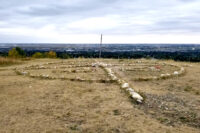Indigenous music in the national spotlight
By Theodora MacLeod - Lethbridge Herald Local Journalism Initiative Reporter on January 24, 2024.
 Canadian Press file photo
Snotty Nose Rez Kids perform during the 2022 Juno Awards in Toronto. There has never been a better time for Indigenous music in Canada as Indigenous musicians have entered the "post-pandemic" era with a bang.
Canadian Press file photo
Snotty Nose Rez Kids perform during the 2022 Juno Awards in Toronto. There has never been a better time for Indigenous music in Canada as Indigenous musicians have entered the "post-pandemic" era with a bang.There has never been a better time for Indigenous music in Canada.
Whether it was the rise of socially engaged movements like Black Lives Matter, or the time artists spent in isolation, Indigenous musicians have entered the “post-pandemic” era with a bang and if listeners are lucky, the industry will never be the same again.
Music media expert Eric Alper calls the pandemic and lockdown, “a great equalizer” in the music industry.
“All of these big, massive changes were happening at the same time,” says Alper.
“Artists who normally would have to save up to put themselves into a recording studio, didn’t need to do that anymore. They were stuck at home; they could get free programs online to help them create music.” He says it was the perfect environment for collaboration, many artists finding opportunities to connect on social media that might otherwise not have been possible had the global pause button not been pressed.
But there was more to it than a stoppage in play.
“A lot of people took a real hard look at themselves and said we need to listen more and talk less. And more importantly, we need to provide more opportunities for these people who might have been marginalized and been a little bit forgotten about,” Alper explains.
If that change in perspective from musical gatekeepers – producers, programmers, talent bookers, and music directors – was the result of internal reflection, or if it came from fear after witnessing an uptick in the onslaught of public scorn directed at those revealed to be misusing their power, cannot be concluded.
More likely, it was a combination of the two.
In the wake of public demonstrations supporting Black Lives Matter, there was a new conversation emerging within the public consciousness. Combined with heightened emotions and stretches of time isolated from others, much of the lenience for intolerance that may have existed before March 2020 was gone. Every day there seemed to be a new call to action, a new target in the efforts for equality.
Now, over a year or so after many of the restrictions were lifted, Alper says there has been tremendous growth in Indigenous representation on the music scene.
From Snotty Nose Rez Kids being shortlisted for the Polaris Prize and OMBIIGIZI’s nomination at the Junos for Alternative Album of the year, to Mattmac winning CBC Music’s Searchlight award, Indigenous artists are starting to get the attention they’ve deserved.
“It doesn’t matter whether or not there is even an audience out there for it.” Alper says when asked if it is a matter of capturing a new market or engaging the existing one.
“We have some wrongs to right and part of that is how this country not only sees the past with Indigenous culture, but what the present and what the future is going to look like for people who don’t get to see themselves in mass media and mass culture.”
Alper says that he is now seeing Indigenous artists get opportunities they likely wouldn’t have just five years ago.
“My media database has gone from-I’m gonna guess-95 per cent white males and females, to a whole rainbow of cultures and names that I can recognize that are not anglo.”
Not only does that kind of growth have a positive impact economically, but it paves the way for more and more Indigenous artists to reach a wider audience. More importantly, it’s going to have a positive impact on future generations. “Somebody like Mattmac winning the CBC Searchlight brings hundreds of Indigenous teenagers to the ability to think ‘I can do it too!’ Snotty Nose Rez Kids going on U.S television, it’s huge, it’s massive.”
When it comes to classifying an artist as Indigenous versus as an Indigenous artist, Alper doesn’t believe a distinction can be made. Separating an artist from their culture is not possible. With that, the work he does for Indigenous clients differs from his non-marginalized ones.
“There’s a little more explanation of the thought process behind the actual creation of the song,” Alper explains.
Including details such as language translations and information on clothing or context not only allows the people making decisions to understand the artist and the work on the same level they might another artist, but it shows how easy it can be to explain to audiences.
Though social media has shattered the idea of a mainstream music scene in many ways, especially when comparing listening habits to those in the 1980s, it has opened a world of new possibilities to artists who may have otherwise not been heard and allowed audiences to find their niche. Luckily, through it all has emerged recognition for a music scene of Indigenous artists that Canadians are ready to hear.
22-21




